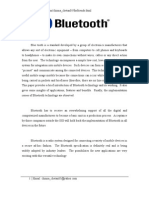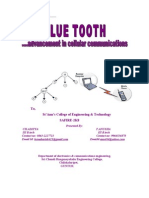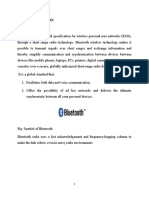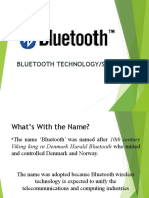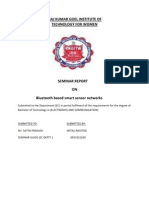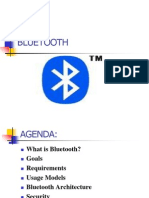Bluetoothtechnology 1
Bluetoothtechnology 1
Uploaded by
Rahul NairCopyright:
Available Formats
Bluetoothtechnology 1
Bluetoothtechnology 1
Uploaded by
Rahul NairOriginal Title
Copyright
Available Formats
Share this document
Did you find this document useful?
Is this content inappropriate?
Copyright:
Available Formats
Bluetoothtechnology 1
Bluetoothtechnology 1
Uploaded by
Rahul NairCopyright:
Available Formats
BLUETOOTH TECHNOLOGY
ABSTRACT
Bluetooth is a radio frequency specification for short range, point to point
and point to multi point voice and data transfer. Bluetooth technology
facilitates the replacement of cables normally used to connect one device
to another by a short range radio link. With the help of blue tooth we can
operate our keyboard and mouse without direct connection of CPU.
Printers, fax machines, headphone, mouse, keyboard or any other digital
devices can be part of Bluetooth system.
In spite of facilitating the replacement of cables, Bluetooth technology
works as an universal medium to bridge the existing data networks, a
peripheral interface for existing devices and provide a mechanism to
form short ad hok network of connected devices away from fixed
network infrastructures.
Due to their independence on short range radio link, Bluetooth devices do
not require a line of site connection in order to communicate. Therefore a
computer can print information on a printer if printer is in inside the
room. Two blue tooth devices can talk to each other when they come
within range of 10 meters to each other.
Bluetooth technology represents an opportunity for the industry to deliver
wireless solutions that are ubiquitous across a broad range of devices.
St.Berchmans Off Campus Centre 1
BLUETOOTH TECHNOLOGY
INTRODUCTION
While many new technologies bear technical names, like RS-232 or
IEEE
802.11b, Bluetooth, the wireless technology, is different.
Bluetooth was named for the 10th Century Viking king , Harald Blatand
(A.K.A., Bluetooth) who peacefully united all the tiny island kingdoms
of
Denmark, southern Sweden, and southern Norway into one country . In
keeping with its namesake, Bluetooth, the new low-cost radio
technology, is
designed to unite or connect all different types of devices to effectively
work
as one. By uniting devices, Bluetooth eliminates the need for cabling in a
wide range of products, including cellular phones, PCs, headphones,
audio
equipment, printers, and many more.
St.Berchmans Off Campus Centre 2
BLUETOOTH TECHNOLOGY
Bluetooth Definitions
• Piconet: Devices connected in an ad hoc fashion, that is, not
requiring predefinition and planning, as with a standard network.
Two to eight devices can be networked into a piconet. It is a peer
network, that is, once connected, each device has equal access to
the others. However, one device is defined as master, and the
others as slaves.
• Scatternet: Several piconets may form a larger scatternet, with
each piconet maintaining independence.
• Master unit: The master in a piconet whose clock and hopping
sequence synchronizes the other devices.
• Slave unit: Devices in a piconet that are not the master.
• MAC address: Three bit address that distinguishes each unit in a
piconet.
• Parked units: Piconet devices that are synchronized but don't have
MAC addresses.
• Sniff and hold mode: Power-saving mode of a piconet device.
St.Berchmans Off Campus Centre 3
BLUETOOTH TECHNOLOGY
WORKING
The technology of Bluetooth centers aIround a 9mm x 9mm microchip,
which functions as a low cost and short range radio link. Bluetooth
Technology provide a 10 meter personal bubble that support
simultaneous transmission of both voice
and data for multiple devices. Up to 8 devices can be connected in a
piconet, and uo to 10 piconets can exist within the 10 meter bubble. Each
piconet support
up to 3 simultaneous full duplex voice devices.
The gross data rate is 1 Mb/s, but the actual data rate are 432 kbps full
duplex transmission,721/56kbps for asymmetric transmission, and 384
kbps for
tms2000 transmission.
Bluetooth wireless technology is designed to be as secure as a wire
with up to 128-bit public/private key authentication, and streaming cipher
up to 64 bit based on a5 security.
Transmission types and rates :
The baseband (single channel per line) protocol combines circuit and
packet switching. To assure that packets do not arrive out of order, slots
(up to five) can be reserved for synchronous packets. As noted earlier, a
different hop signal is used for each packet. Circuit switching can be
either asynchronous or synchronous. Up to three synchronous (voice)
data channels, or one synchronous and one asynchronous data channel,
can be supported on one channel. Each synchronous channel can support
St.Berchmans Off Campus Centre 4
BLUETOOTH TECHNOLOGY
a 64 Kb/s transfer rate, which is fully adequate for voice transmissions.
An asynchronous channel can transmit as much as 721 Kb/s in one
direction and 57.6 Kb/s in the opposite direction. It is also possible for an
asynchronous connection to support 432.6 Kb/s in both directions if the
link is symmetric.
Radio frequency and spectrum hopping :
What if there's a lot of radio noise? Won't that interfere with Bluetooth
connections? As a rule, the answer is no. It is designed to use fast
acknowledgement and frequency hopping, which will make connections
robust. It is packet-based, and will jump to a new frequency after each
packet is received, which not only helps limit interference problems, but
also adds to security. Data rates are one megabyte/second, including
headers. Full duplex transmissions (both directions at once) are
accomplished via time division multiplexing.
The Bluetooth radio chip functions at 2.4 gigahertz, which is in the
unlicensed ISM (Industrial Scientific Medical) band. It separates the 2.4
gigahertz frequency band into 79 hops one megahertz apart, starting with
2.402 and ending with 2.480 (though this bandwidth is narrower in Japan,
France, and Spain). This spread spectrum is used to hop from one
channel to another, pseudo-randomly, which adds a strong layer of
security. Up to 1600 hops per second can be made. The standard
frequency range is 10 centimeters to 10 meters, and can be extended to at
least 100 meters by increasing transmission power.
St.Berchmans Off Campus Centre 5
BLUETOOTH TECHNOLOGY
Data transmission:
Data can be transmitted both synchronously and asynchronously. The
Synchronous Connection Oriented (SCO) method is used primarily for
voice, and Asynchronous Connectionless (ACL) is primarily for data.
Within a piconet, each master-slave pair can use a different transmission
mode, and modes can be changed at any time. Time Division Duplex
(TDD) is used by both SCO and ACL, and both support 16 types of
packets, four of which are control packets that are the same in each type.
Because of the need for smoothness in data transmission, SCO packets
are generally delivered via reserved intervals, that is, the packets are sent
in groups without allowing other transmissions to interrupt. SCO packets
can be transmitted without polling by the sending unit. ACL links support
both symmetric and assymetric transmissions.
Bandwidth is controlled by the master unit, which determines how much
of the total each slave unit can use. Slaves cannot transmit data until they
have been polled by the master, and the master can broadcast messages to
the slave units via ACL link.
Network arrangement:
Bluetooth network arrangements (topology) can be either point-to-point
or point-to-multipoint. Any unit in a piconet can establish a connection
to another piconet to form a scatternet. See the figure, which diagrams a
St.Berchmans Off Campus Centre 6
BLUETOOTH TECHNOLOGY
scatternet in which piconet A, which consists of four units, is connected
to piconet B, consisting of two units. Note that the master unit of A is not
the link Bluetooth network arrangements (topology) can between the two
piconets.
Error correction and security:
on code (FEC), 2/3 rate forward error correction code FEC, and
automatic repeat request (ARQ). The FEC methods are designed to
reduce the number of retransmissions. However, the over hea Three error
correction techniques have been defined: 1/3 rate forward error corrected
significantly slows transmissions, so is generally not used in relatively
error-free environments, with the exception of packet headers. The ARQ
scheme requires that the header error and cyclic redundancy checks are
okay. When they are, an acknowledge is sent. When they aren't, the data
is resent.
St.Berchmans Off Campus Centre 7
BLUETOOTH TECHNOLOGY
Security is provided in three ways: through pseudo-random frequency
band hops, authentication, and encryption. Frequency band hops make
it difficult for anyone to eavesdrop. Authentication allows a user to
control connectivity to only devices specified. Encryption uses secret
key lengths of 1, 40, and 64 bits. The quality of security is excellent
for most applications. However, it is not the highest level available,
and for those users who require it, the suggestion is to investigate
separate network transfer protocols and security software.
Connection Protocol
Bluetooth connections are established via the following techniques:
1. Standby: Devices not connected in a piconet are in standby mode.
In this mode, they listen for messages every 1.28 seconds over 32
hop frequencies (fewer in Japan, Spain, and France).
2. Page/Inquiry: If a device wishes to make a connection with
another device, it sends out a page message, if the address is
known, or an inquiry followed by a page message, if it is unknown.
The master unit sends out 16 identical page messages on 16 hop
frequencies to the slave unit. If there is no response, the master
retransmits on the other 16 hop frequencies. The inquiry method
requires an extra response from the slave unit, since the MAC
address is unknown to the master unit.
3. Active: Data transmission occurs.
St.Berchmans Off Campus Centre 8
BLUETOOTH TECHNOLOGY
4. Hold: When either the master or slave wishes, a hold mode can be
established, during which no data is transmitted. The purpose of
this is to conserve power. Otherwise, there is a constant data
exchange. A typical reason for going into hold mode is the
connection of several piconets.
5. Sniff: The sniff mode, applicable only to slave units, is for power
conservation, though not at as reduced a level as hold. During this
mode, the slave does not take an active role in the piconet, but
listens at a reduced level. This is usually a programmable setting.
6. Park: Park mode is a more reduced level of activity than the hold
mode. During it, the slave is synchronized to the piconet, thus not
requiring full reactivation, but is not part of the traffic. In this state,
they do not have MAC addresses, but only listen enough to keep
their synchronization with the master and check for broadcast
messages.
St.Berchmans Off Campus Centre 9
BLUETOOTH TECHNOLOGY
USAGE MODEL:
While the Bluetooth * usage model is based on connecting devices
together, it is focused on three broad categories: voice/data access points,
peripheral interconnects, and Personal Area Networking (PAN).
St.Berchmans Off Campus Centre 10
BLUETOOTH TECHNOLOGY
Voice/Data Access Points:
Voice/data access points is one of the key initial usage models and
involves connecting a computing device to a communicating device via a
secure wireless link (see Figure 1). For example, a mobile computer
equipped with Bluetooth technology could link to a mobile phone that
uses Bluetooth technology to connect to the Internet to access e-mail. The
mobile phone acts as a personal
access point. Even more ideal, the notebook can connect to the Internet
while the cell phone is being carried in a briefcase or purse. The
St.Berchmans Off Campus Centre 11
BLUETOOTH TECHNOLOGY
Bluetooth usage model also envisions public data access points in the
future. Imagine the current data-equipped pay phones in airports being
upgraded with Bluetooth modems. This would allow any mobile device
equipped with Bluetooth technology to easily connect to the Internet
while located within ten meters of that access point. These access points
could, of course, support much higher data rates than today’s modems, as
public spaces could connect a variety of private Bluetooth access points
via a LAN that is routed to the Internet over a DSL line, allowing each
access point a private 1Mbps connection to the Internet.
Peripheral Interconnects :
The second category of uses, peripheral interconnects, involves
connecting other devices together as shown in Figure 2. Imagine standard
St.Berchmans Off Campus Centre 12
BLUETOOTH TECHNOLOGY
keyboards, mice, and joysticks that work over a wireless link. The
Bluetooth link is built into the mobile computer; therefore, the cost of the
peripheral device is less because an access point is not needed.
Additionally, many of these devices can be used in multiple markets. For
example, a Bluetooth headset used in the office could be connected to a
Bluetooth access point that provides access to the office phone and multi-
media functions of the mobile computer. When mobile, the same headset
could be used to interface with the cellular phone (which can now remain
in a
briefcase or purse).Another aspect of a short-range link like Bluetooth is
in the area of proximity security devices. In this case, if one device is not
within range of another device, the first device will go into a high
security mode.
St.Berchmans Off Campus Centre 13
BLUETOOTH TECHNOLOGY
Personal Area Networking:
The last usage model, Personal Area Networking (PAN), focuses on the
ad-hoc formation and breakdown of personal networks(see Figure 3).
Imagine meeting someone in an airport and quickly and securely
exchanging documents by establishing a private piconet. In the future,
Bluetooth kiosks could provide access to electronic media that could be
quickly downloaded for later access on the mobile device.
St.Berchmans Off Campus Centre 14
BLUETOOTH TECHNOLOGY
Bluetooth Special Interest group (SIG)
Bluetooth special group is group of companies working together to
define, developed promote an open royalty free specification for seamless
wireless connectivity and cable replacement for a wide variety of
mobility-enhancing devices. The original charter of the SIG is to monitor
the technical development of a short range radio and to create an open
global standard. It prevent the technology from becoming the property of
any single company.
In developing the Bluetooth specification, the SIG is strictly adhering
to some basic principles that that can be summed up in five key words:
freedom, security, simplicity, versatility and reliability. These keywords
are the foundation of Bluetooth technology. To be Bluetooth certified, a
device must pass interoperability testing by the Bluetooth Special Interest
Group thus assuring that products meeting the specification will be able
to interact with all other Bluetooth-certified products and with the
Internet.
St.Berchmans Off Campus Centre 15
BLUETOOTH TECHNOLOGY
In february1998, the Special Interest Group (SIG) was formed. The
founding SIG member are Ericsson, Intel, IBM, Nokia & Toshiba. Since
then over 2000 adopter have joined including Compaq, Lucent, Motorola
and 3com.
St.Berchmans Off Campus Centre 16
BLUETOOTH TECHNOLOGY
Bluetooth Characteristics:
These are the features of the Bluetooth technology:
• It separates the frequency band into hops. This spread spectrum is
used to hop from one channel to another, which adds a strong layer
of security.
• Up to eight devices can be networked in a piconet.
• Signals can be transmitted through walls and briefcases, thus
eliminating the need for line-of-sight.
• Devices do not need to be pointed at each other, as signals are
omni-directional.
• Both synchronous and asynchronous applications are supported,
making it easy to implement on a variety of devices and for a
variety of services, such as voice and Internet.
• Governments worldwide regulate it, so it is possible to utilize the
same standard wherever one travels.
St.Berchmans Off Campus Centre 17
BLUETOOTH TECHNOLOGY
Competing technologies
While there is no single competing technology that covers the entire
concept of Bluetooth wireless technology, in certain market segment
other technology do exist.
IrDA
For cable replacement, the infrared standard IrDA has been around
for several years and is quite widespread. Most new portable PCs, PDAs,
and some cellular phones support IrDA, although actual adoption by
users has been rather limited. IrDA is faster than Bluetooth but is limited
to point to point connections,
Whereas Bluetooth is also capable to point to multi point. IrDA’s biggest
draw back is that it requires a clear line to sight, and is usually limited to
a few feet between devices.
Wireless LAN:
Wireless LAN based on the IEEE 802.11b standard are used to
replace a wired LAN throughout a building. The transmission capacity is
high and so is the number of simultaneous users. However, compared to
Bluetooth, these wireless LANs are more expensive, consume more
St.Berchmans Off Campus Centre 18
BLUETOOTH TECHNOLOGY
power and have a larger hardware footprint, making them unsuitable for
small mobile devices.
St.Berchmans Off Campus Centre 19
BLUETOOTH TECHNOLOGY
BLUETOOTH IN FUTURE
What is the future direction of the Bluetooth standard?
At this time, we anticipate the Bluetooth SIG to evolve the Bluetooth
technology to provide greater bandwidth & distances, thus increasing the
potential platforms & applications used in the emerging personal area-
networking marketplace.
What is the future of Bluetooth?
Bluetooth is a continually expanding technology. There are plans to add
many new application profiles. With over 1800 companies working on
Bluetooth, the future could not be brighter. With a strong special interest
group behind Bluetooth, the standardization of the application profiles is
almost assured.
St.Berchmans Off Campus Centre 20
BLUETOOTH TECHNOLOGY
According to market researchers, Cahners In-Stat Group, it is anticipated
that as many as 670 million products will have Bluetooth built-in by the
year 2005.
Will the speed of Bluetooth increase?
Some members of the Bluetooth SIG such as Sony & Eastman Kodak are
interested in seeing the speed of Bluetooth increasing for applications
such as streaming video. Proposals are under consideration but it is not
clear when products based on any of the proposals would be available
Projected Market Growth:
Cahners In-Stat group estimates that the Bluetooth market will grow from
virtually zero in 1999 to over 1 billion Bluetooth-enabled devices that
will
ship in 2005.
St.Berchmans Off Campus Centre 21
BLUETOOTH TECHNOLOGY
ADVANTAGES OF BLUETOOTH
TECHNOLOGY:
1.No line of site restrictions as with IrDA.
2. Low power consumption makes integrated in battery powered
devices
very practical.
3. 2.4 GHz radio frequency ensures worldwide operability.
St.Berchmans Off Campus Centre 22
BLUETOOTH TECHNOLOGY
4. Tremendous momentum not only within the computer industry
but other industries like cellular telephones and transportation.
APPLICATIONS
Smart Home
Homes equipped with Bluetooth devices may be able to recognise the
arrival of its bonafideI residents and unlock the door on their arrival. The
device will also adjust heat to a preset temperature. While this is
St.Berchmans Off Campus Centre 23
BLUETOOTH TECHNOLOGY
happening, the data from the individual’s PDA may be exchanged with
the home electronic board, and the family calendar is updated
to reflect the scheduled activities in the office.
The Internet Bridge
An extension of this model could be a mobile computer that allows
surfing the Internet irrespective of the location of the user, and regardless
of whether the user is cordlessly connected through a mobile phone
(cellular) or through a wire line connection (e.g. PSTN, ISDN, LAN,
xDSL).
Automatic Check-in:
• Hotels are testing, or plan to test, services that allow guests to
check in, unlock room doors and even control room temperature
with handheld devices equipped with Bluetooth Technology.
• The Bluetooth enabled mobile phone or the PDA can present the
electronic ticket to the airline system without one having to go
through the queue at the check-in counters. The airline's on-line
system performs the identification via the ID-tag feature built into
the mobile phone or the PDA and confirms the reserved seat.
St.Berchmans Off Campus Centre 24
BLUETOOTH TECHNOLOGY
The Three-in-one Phone
With Bluetooth support, one handset will be able to provide multiple
functionality. When at home, the phone functions as a cordless phone,
connected to the fixed line. When on the move, it functions as a mobile
phone connected to the mobile network. Additionally, when the phone
comes within range of another mobile phone with built-in Bluetooth
technology, it functions as a walkie-talkie.
St.Berchmans Off Campus Centre 25
BLUETOOTH TECHNOLOGY
BIBLIOGRAPHY
1. The official Bluetooth site,http:/www.bluetooth.com
2. http://www.intel.com/mobile/bluetooth
3. The wireless connectivity Technologies Comparison, Infrared and
Radio Frequency, Infrared Data Association, September 1998.
St.Berchmans Off Campus Centre 26
You might also like
- I-Tel Business PlanDocument67 pagesI-Tel Business PlanInfiniteKnowledgeNo ratings yet
- IELTS Advanced Intensive - Listening - Extra Practice Test 1 - Test PaperDocument7 pagesIELTS Advanced Intensive - Listening - Extra Practice Test 1 - Test PaperPhạm Linh50% (2)
- Bluetooth TechnologyDocument13 pagesBluetooth TechnologyK.Rohit GoudNo ratings yet
- Bluetooth TechnologyDocument13 pagesBluetooth TechnologysneharachNo ratings yet
- Bluetooth TechDocument23 pagesBluetooth Techapi-3746880100% (1)
- Bluetooth Technology Seminar ReportDocument23 pagesBluetooth Technology Seminar ReportAbhinav KumarNo ratings yet
- Bluetooth TechnologyDocument19 pagesBluetooth TechnologyToaster97No ratings yet
- Bluetooth Technology Seminar Report.docDocument21 pagesBluetooth Technology Seminar Report.docWasif BahoorNo ratings yet
- Submitted in Partial Fulfillment of Award of Degree of Bachelor of Technology in Computer Science and EngineeringDocument22 pagesSubmitted in Partial Fulfillment of Award of Degree of Bachelor of Technology in Computer Science and EngineeringAmol ChaudhariNo ratings yet
- Introduction To Bluetooth Technology: Why It's Name Is Bluetooth?Document8 pagesIntroduction To Bluetooth Technology: Why It's Name Is Bluetooth?Mishthi ErNo ratings yet
- Bluetooth Technology Seminar Report PDFDocument21 pagesBluetooth Technology Seminar Report PDFSuvankar DasNo ratings yet
- Bluetooth Thechnology: Introduction To Bluetooth TechnologyDocument10 pagesBluetooth Thechnology: Introduction To Bluetooth Technologyaravind44555No ratings yet
- Bluetooth Technology PresentationDocument29 pagesBluetooth Technology PresentationMihai BogdanNo ratings yet
- Abstract:: The Bluetooth TechnologyDocument8 pagesAbstract:: The Bluetooth Technologymohd shafeeNo ratings yet
- Bluetooth Technology Paper Presentation 100115092505 Phpapp01Document25 pagesBluetooth Technology Paper Presentation 100115092505 Phpapp01pratik269No ratings yet
- Bluetooth: Blaatand Translates To Bluetooth in EnglishDocument8 pagesBluetooth: Blaatand Translates To Bluetooth in EnglishTushar SaxenaNo ratings yet
- Bluetooth TechnologyDocument17 pagesBluetooth TechnologyAbhinay GuptaNo ratings yet
- Seminar On Bluetooth: Abinash Ojha Reg. No.-0501206108 Branch-ENTC Ajay-Binay Institute of Technology, CTCDocument22 pagesSeminar On Bluetooth: Abinash Ojha Reg. No.-0501206108 Branch-ENTC Ajay-Binay Institute of Technology, CTCAnnada Prasanna DasNo ratings yet
- Bluetooth TechnologyDocument11 pagesBluetooth TechnologyRam Kumar Bhandari100% (1)
- Report On Bluetooth® NetworkingDocument15 pagesReport On Bluetooth® NetworkingSubash PandeyNo ratings yet
- Bluetooth ArchitectureDocument9 pagesBluetooth ArchitectureLilambuj KumarNo ratings yet
- A Presentation by:-M.Sai Adithya & Ashwin Kumar Chordiya 3-1 Btech, Ece, GnecDocument23 pagesA Presentation by:-M.Sai Adithya & Ashwin Kumar Chordiya 3-1 Btech, Ece, GnecSai AdithyaNo ratings yet
- Technical Report On BluetoothDocument21 pagesTechnical Report On BluetoothManisha Gupta50% (4)
- Bluetooth FinalDocument9 pagesBluetooth Finaldhruba88No ratings yet
- Bluetooth TechnologyDocument13 pagesBluetooth TechnologyParthasarathi AnbalaganNo ratings yet
- BluetoothDocument14 pagesBluetoothSuriyaa SugumarNo ratings yet
- "MMMM #M: MM M M MM M!Document21 pages"MMMM #M: MM M M MM M!waqaskhattakNo ratings yet
- Bluetooth Technology: Mobile ComputingDocument12 pagesBluetooth Technology: Mobile Computingrws1000No ratings yet
- Bluetooth Technology in Wireless Communications: Paper Presentation OnDocument11 pagesBluetooth Technology in Wireless Communications: Paper Presentation Onpraveen_449100% (2)
- BluetoothDocument8 pagesBluetoothGouse111No ratings yet
- Blue ToothDocument11 pagesBlue ToothSumanth DontineniNo ratings yet
- Bluetoothtechnology: Seminor OnDocument9 pagesBluetoothtechnology: Seminor OnNitturi VinodkumarNo ratings yet
- Bluetooth Technology SeminarDocument16 pagesBluetooth Technology SeminarMajestyNo ratings yet
- Competitive Exams Bluetooth Functioning: ExamraceDocument4 pagesCompetitive Exams Bluetooth Functioning: ExamraceRaja PosupoNo ratings yet
- The Bluetooth SystemDocument16 pagesThe Bluetooth Systemy.priyankareddy7661No ratings yet
- Bluetooth: BY 08601A1212 08601A1232Document21 pagesBluetooth: BY 08601A1212 08601A1232venkatsantoshdNo ratings yet
- BluetoothDocument3 pagesBluetoothelaNo ratings yet
- BluetoothDocument27 pagesBluetoothshanty85No ratings yet
- Bluetooth SecurityDocument34 pagesBluetooth SecurityGanesh KwaradiNo ratings yet
- Properties of Bluetooth SystemDocument2 pagesProperties of Bluetooth SystemIzzat IrfanNo ratings yet
- Bluetooth Based Sensor Networks: CSE C. Bhanu Prakash Reddy 1Document15 pagesBluetooth Based Sensor Networks: CSE C. Bhanu Prakash Reddy 1codineshNo ratings yet
- What Is BluetoothDocument32 pagesWhat Is BluetoothHeni Jayanti SutadiNo ratings yet
- Welcome To Bluetooth Technology: Presented by M.L.Nikhil (09MD1A0438), III E.C.E G.J.S.Pavan Kumar (09MD1A0417), III E.C.EDocument24 pagesWelcome To Bluetooth Technology: Presented by M.L.Nikhil (09MD1A0438), III E.C.E G.J.S.Pavan Kumar (09MD1A0417), III E.C.Eplanetshacker100% (2)
- Bluetooth IntroductionDocument4 pagesBluetooth IntroductiongowdamandaviNo ratings yet
- Raj Kumar Goel Institute of Technology For WomenDocument64 pagesRaj Kumar Goel Institute of Technology For WomenSpicymitthu MitalirastogiNo ratings yet
- What Is BluetoothDocument4 pagesWhat Is BluetoothArpit SrivastavaNo ratings yet
- Bluetooth: Seminar Report ForDocument16 pagesBluetooth: Seminar Report FortravelnagaNo ratings yet
- BluetoothDocument5 pagesBluetoothswatimithuNo ratings yet
- BluetoothDocument8 pagesBluetoothVignesh SbNo ratings yet
- Bluetooth: Author: Asharani P. Mirazkar Vijaylaxmi A. HorakeriDocument7 pagesBluetooth: Author: Asharani P. Mirazkar Vijaylaxmi A. Horakeriapi-19799369No ratings yet
- Bluetooth: Presenters: Group 6Document31 pagesBluetooth: Presenters: Group 6Sumit KhilariNo ratings yet
- Bluetooth 1Document41 pagesBluetooth 1Neha PushpaNo ratings yet
- List of ContentsDocument13 pagesList of ContentsBedigi SridharNo ratings yet
- Bluetooth: Name and LogoDocument19 pagesBluetooth: Name and LogoGurvinder SinghNo ratings yet
- Bluetooth Is A TechnologyDocument7 pagesBluetooth Is A TechnologyChandan DattaNo ratings yet
- Cisco Certified Network Associate (CCNA) and Cisco Certified Network Professional (CCNP): Mastering Network Automation and Programmability Study GuideFrom EverandCisco Certified Network Associate (CCNA) and Cisco Certified Network Professional (CCNP): Mastering Network Automation and Programmability Study GuideNo ratings yet
- CompTIA Network+ (N10-009) Study Guide: Comprehensive Exam Preparation and Key Concepts for Network ProfessionalsFrom EverandCompTIA Network+ (N10-009) Study Guide: Comprehensive Exam Preparation and Key Concepts for Network ProfessionalsNo ratings yet
- Computer Networking: An introductory guide for complete beginners: Computer Networking, #1From EverandComputer Networking: An introductory guide for complete beginners: Computer Networking, #1Rating: 4.5 out of 5 stars4.5/5 (2)
- Introduction to Internet & Web Technology: Internet & Web TechnologyFrom EverandIntroduction to Internet & Web Technology: Internet & Web TechnologyNo ratings yet
- IT Companies HydDocument127 pagesIT Companies HydA VenkatNo ratings yet
- Quectel BC660K-GL-TE-B User Guide V1.0Document31 pagesQuectel BC660K-GL-TE-B User Guide V1.0Levent BirgulNo ratings yet
- The Cross Platform Report Q4-2011 (Nielsen) - May12Document7 pagesThe Cross Platform Report Q4-2011 (Nielsen) - May12retelurNo ratings yet
- GPS TRAKER User-Manual-3470390 PDFDocument30 pagesGPS TRAKER User-Manual-3470390 PDFrot865No ratings yet
- 2020 Grade 4 Notes Science and Technology Week 1 Week 3 Term 2-25-20 May 15-09-30Document23 pages2020 Grade 4 Notes Science and Technology Week 1 Week 3 Term 2-25-20 May 15-09-30Sophia KariukiNo ratings yet
- Light Fidelity Technology: Seminar ReportDocument52 pagesLight Fidelity Technology: Seminar ReportManwee SahuNo ratings yet
- Reactive Anti-Drone and Cellular Jammer Solution - Ohmsiber 06122019Document7 pagesReactive Anti-Drone and Cellular Jammer Solution - Ohmsiber 06122019anwar mustofaNo ratings yet
- Information Technology in Dairy IndustryDocument194 pagesInformation Technology in Dairy IndustryGanesh JadhavNo ratings yet
- Matrix Eternity Ip-Pbx BrochureDocument8 pagesMatrix Eternity Ip-Pbx Brochurepskulkarni82No ratings yet
- EMarketer Forecasting Analyst TestDocument5 pagesEMarketer Forecasting Analyst Testshikhar.guptaNo ratings yet
- Evidencia de Fiscalía Federal Caso Tata CharbonierDocument9 pagesEvidencia de Fiscalía Federal Caso Tata CharbonierVictor Torres MontalvoNo ratings yet
- Tangible Intangible Cost Benefit Sheet - Jose EscanioDocument2 pagesTangible Intangible Cost Benefit Sheet - Jose Escaniojose escanioNo ratings yet
- Vodafone Mobile Broadband 10 5-7-56405 RC1 ReadMeDocument23 pagesVodafone Mobile Broadband 10 5-7-56405 RC1 ReadMemohammed attiaNo ratings yet
- A Mini Project Report Mba 1st SemDocument49 pagesA Mini Project Report Mba 1st SemAnish SharmaNo ratings yet
- PORTFOLIO ARW3 Daniela EliasDocument16 pagesPORTFOLIO ARW3 Daniela Eliasedumayzu MayhuireNo ratings yet
- Catat Dan Lat Explanation Text - AbcDocument3 pagesCatat Dan Lat Explanation Text - AbcDennis StwnNo ratings yet
- Telenor B2B Generic PortfolioDocument42 pagesTelenor B2B Generic PortfolioAhsenNo ratings yet
- Smarttnt MNP Sim Activation Faqs 20220218Document3 pagesSmarttnt MNP Sim Activation Faqs 20220218Grace MendarosNo ratings yet
- User'S Guide: Smart Security SystemDocument25 pagesUser'S Guide: Smart Security SystemlccNo ratings yet
- FAQ On Mobile Banking ServicesDocument8 pagesFAQ On Mobile Banking Servicessimar raiNo ratings yet
- Ran Optimization PDFDocument9 pagesRan Optimization PDFYoucef BelhadiaNo ratings yet
- Bkash BangladshDocument7 pagesBkash BangladshZihad Al AminNo ratings yet
- E CitizenshipDocument229 pagesE CitizenshipMarlou TangalinNo ratings yet
- Business & Innovation: Mobike: BMO2005 Innovation and Entrepreneurship Assignment 2Document22 pagesBusiness & Innovation: Mobike: BMO2005 Innovation and Entrepreneurship Assignment 2illidanNo ratings yet
- RF Drive Test (Testing) ManualDocument11 pagesRF Drive Test (Testing) ManualRamil FernandezNo ratings yet
- Project On Consumer Behaviour Towards Mobile MarketingDocument76 pagesProject On Consumer Behaviour Towards Mobile MarketingKrunal Viradia100% (1)
- FreedomBill 20221020Document8 pagesFreedomBill 20221020Payroll TeamNo ratings yet


























